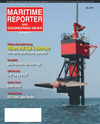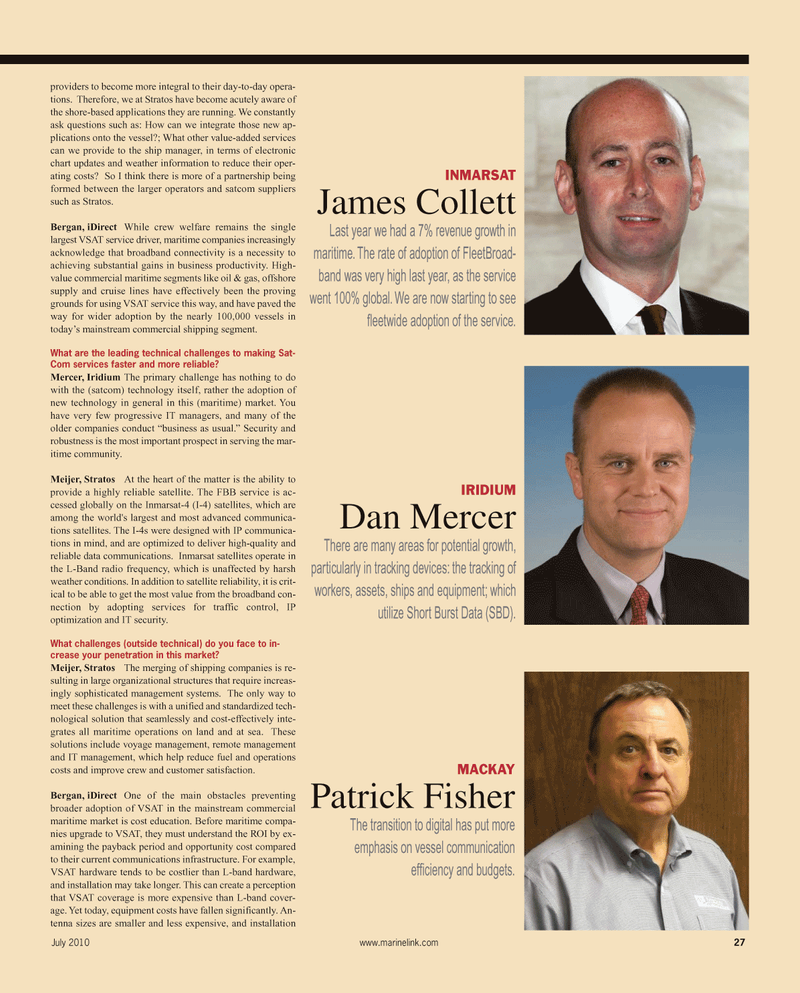
Page 27: of Maritime Reporter Magazine (July 2010)
Satellite Communication Edition
Read this page in Pdf, Flash or Html5 edition of July 2010 Maritime Reporter Magazine
July 2010 www.marinelink.com 27
INMARSAT
James Collett
Last year we had a 7% revenue growth in maritime. The rate of adoption of FleetBroad- band was very high last year, as the service went 100% global. We are now starting to see fleetwide adoption of the service.
IRIDIUM
Dan Mercer
There are many areas for potential growth, particularly in tracking devices: the tracking of workers, assets, ships and equipment; which utilize Short Burst Data (SBD).
MACKAY
Patrick Fisher
The transition to digital has put more emphasis on vessel communication efficiency and budgets. providers to become more integral to their day-to-day opera- tions. Therefore, we at Stratos have become acutely aware of the shore-based applications they are running. We constantly ask questions such as: How can we integrate those new ap- plications onto the vessel?; What other value-added services can we provide to the ship manager, in terms of electronic chart updates and weather information to reduce their oper- ating costs? So I think there is more of a partnership being formed between the larger operators and satcom suppliers such as Stratos.
Bergan, iDirect While crew welfare remains the single largest VSAT service driver, maritime companies increasingly acknowledge that broadband connectivity is a necessity to achieving substantial gains in business productivity. High- value commercial maritime segments like oil & gas, offshore supply and cruise lines have effectively been the proving grounds for using VSAT service this way, and have paved the way for wider adoption by the nearly 100,000 vessels in today’s mainstream commercial shipping segment.
What are the leading technical challenges to making Sat-
Com services faster and more reliable?
Mercer, Iridium The primary challenge has nothing to do with the (satcom) technology itself, rather the adoption of new technology in general in this (maritime) market. You have very few progressive IT managers, and many of the older companies conduct “business as usual.” Security and robustness is the most important prospect in serving the mar- itime community.
Meijer, Stratos At the heart of the matter is the ability to provide a highly reliable satellite. The FBB service is ac- cessed globally on the Inmarsat-4 (I-4) satellites, which are among the world's largest and most advanced communica- tions satellites. The I-4s were designed with IP communica- tions in mind, and are optimized to deliver high-quality and reliable data communications. Inmarsat satellites operate in the L-Band radio frequency, which is unaffected by harsh weather conditions. In addition to satellite reliability, it is crit- ical to be able to get the most value from the broadband con- nection by adopting services for traffic control, IP optimization and IT security.
What challenges (outside technical) do you face to in- crease your penetration in this market?
Meijer, Stratos The merging of shipping companies is re- sulting in large organizational structures that require increas- ingly sophisticated management systems. The only way to meet these challenges is with a unified and standardized tech- nological solution that seamlessly and cost-effectively inte- grates all maritime operations on land and at sea. These solutions include voyage management, remote management and IT management, which help reduce fuel and operations costs and improve crew and customer satisfaction.
Bergan, iDirect One of the main obstacles preventing broader adoption of VSAT in the mainstream commercial maritime market is cost education. Before maritime compa- nies upgrade to VSAT, they must understand the ROI by ex- amining the payback period and opportunity cost compared to their current communications infrastructure. For example,
VSAT hardware tends to be costlier than L-band hardware, and installation may take longer. This can create a perception that VSAT coverage is more expensive than L-band cover- age. Yet today, equipment costs have fallen significantly. An- tenna sizes are smaller and less expensive, and installation

 26
26

 28
28
